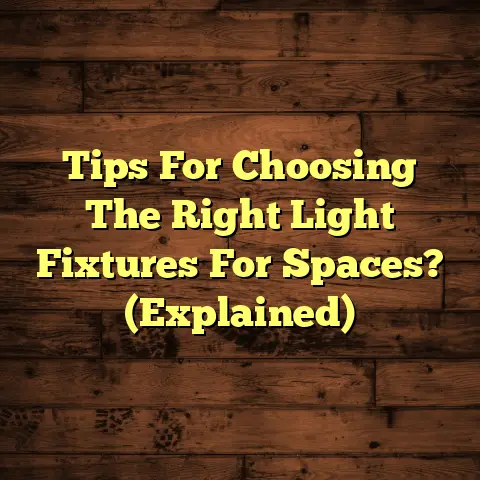Flooring That Goes With Hardwood? (3 Match Musts!)
It’s beautiful, durable, and surprisingly
easy to care for.
A quick sweep and occasional
mopping usually does the trick.
Plus, a good refinishing can bring it back to life.
But sometimes, you want to mix things up, right?
Maybe you love hardwood in your living room,
but need something different for the kitchen or bathroom.
That’s where things can get tricky.
How do you choose flooring that complements
your hardwood without clashing?
Don’t worry, I’ve got you covered.
In this article, I’ll break down the three “musts”
for picking flooring that goes perfectly with hardwood.
Let’s dive in!
The Importance of Cohesion in Flooring
Think of your home as a canvas.
Each room is a different part of the painting,
and the flooring is the foundation.
You want everything to flow together, right?
A unified aesthetic is key.
Your flooring choices play a HUGE role in the overall
design and feel of your space.
Imagine having a gorgeous, warm hardwood floor
in your living room, and then stepping into a kitchen
with cold, stark tile that just doesn’t vibe.
It throws everything off!
Flooring isn’t just about what looks good next to your
hardwood.
You also need to consider factors like:
- Color: Do the tones complement each other?
- Texture: Does the surface feel good underfoot, and does it add visual interest?
- Function: Is the flooring suitable for the room it’s in (e.g., moisture-resistant in a bathroom)?
Hardwood shines in living rooms, dining areas,
and bedrooms.
It brings warmth and elegance.
But let’s be real, it’s not always the best choice
for bathrooms or kitchens where moisture is a constant
threat.
That’s where you need alternatives that play
nice with your existing hardwood.
Think about it this way: You wouldn’t wear a tuxedo
to the gym, right?
Same goes for flooring.
Each space has its own needs and personality.
Match Must #1 – Color Coordination
Alright, let’s get into the first “must”: color coordination.
This is HUGE.
Choosing the right colors can make or break
the entire look of your home.
The goal is to harmonize with the natural tones
of your hardwood.
You don’t want to exactly match,
but you do want to create a sense of flow.
Think about your hardwood.
Is it a light oak?
A dark walnut?
A reddish cherry?
The color palette you choose should complement that.
Here are some ideas:
- Light Oak: Light-colored tiles (like a creamy beige or light gray), muted carpets (think soft blues or greens), or luxury vinyl plank (LVP) that mimics a lighter wood tone.
- Dark Walnut: Slate tiles, darker carpets (like a charcoal gray or deep blue), or even a patterned tile with dark accents can look stunning.
- Reddish Cherry: Earthy tones like browns, greens, or even a subtle terracotta can balance the redness.
I always tell my clients to grab samples.
Bring them home and put them next to your hardwood.
See how the colors play off each other in different lights.
Pro Tip: Pay attention to the undertones.
Does your hardwood have warm undertones (yellow, red)?
Or cool undertones (gray, blue)?
Choose flooring with similar undertones for a cohesive look.
Let’s say you have a beautiful light oak floor.
Pairing it with a dark, espresso-colored tile would
create a jarring contrast.
But a light gray tile?
That could be a match made in heaven!
The key is to create a seamless transition.
You want the eye to move effortlessly from one room
to the next.
Match Must #2 – Texture Harmony
Now, let’s talk about texture.
This is where things get interesting.
Texture can add depth, interest, and a whole new level of
comfort to your home.
Think about the difference between a smooth, polished tile
and a plush, shag carpet.
They feel completely different underfoot, right?
And they create a different visual impact.
You want to choose textures that enhance, not detract from,
the beauty of your hardwood.
A good rule of thumb is to create contrast.
If your hardwood is smooth and polished, consider adding
a textured rug or a tile with a slightly rough surface.
This adds visual interest and prevents the space from feeling flat.
Here are some texture ideas:
- Smooth Tiles: Great for bathrooms and kitchens. Easy to clean and maintain.
- Plush Carpets: Perfect for bedrooms and living rooms. Adds warmth and comfort.
- Textured Laminates: Can mimic the look of wood or stone with added texture.
I had a client once who had beautiful, glossy hardwood
throughout her main living area.
She wanted to add a rug to
her living room, but she was worried about it clashing.
We ended up choosing a rug with a high pile and a subtle,
geometric pattern.
The texture of the rug created a cozy,
inviting feel, and the pattern added visual interest
without overwhelming the hardwood. It was the perfect balance!
Consider where texture plays a crucial role.
A plush rug in a living room with hardwood floors invites you
to sink in and relax.
Textured tiles in a mudroom
can help hide dirt and debris, while also providing
a non-slip surface.
Texture isn’t just about aesthetics;
it’s also about function.
Match Must #3 – Functionality and Purpose
Okay, let’s get practical.
Functionality is the final piece
of the puzzle.
You need to choose flooring that not only looks
good but also meets the demands of each space.
Think about high-traffic areas like entryways and hallways.
These areas need durable, easy-to-clean flooring that can
withstand a lot of wear and tear.
Moisture-prone rooms like bathrooms and kitchens require
flooring that is water-resistant or waterproof.
You don’t want to end up with mold or mildew!
And quieter spaces like bedrooms and home offices can benefit from softer, warmer flooring options that create a cozy and inviting atmosphere.
Here are some functional flooring options:
- Kitchens: Tile (porcelain or ceramic), luxury vinyl plank (LVP), or sheet vinyl.
These are all durable, water-resistant, and easy to clean. - Bathrooms: Tile (especially porcelain), LVP, or stone. Again, water resistance is key.
- Bedrooms: Carpet, hardwood, or laminate. Comfort and warmth are important here.
- Living Rooms: Hardwood, carpet, rugs, or even a combination of these.
I worked on a project where the client wanted to extend
their hardwood floors into the kitchen.
I advised against it.
Kitchens are messy!
Spills happen.
Instead, we chose a beautiful porcelain tile that looked
almost identical to the hardwood.
It gave them the look
they wanted, with the added benefit of being waterproof and easy to clean.
Functionality also ties into aesthetics.
You don’t want to choose a flooring option that looks
great but is completely impractical for the space.
For example, a delicate silk rug might look stunning in a formal living room, but it’s not exactly ideal for a family room where kids and pets are running around.
Choosing the right flooring is about finding that sweet spot
where beauty and practicality meet.
It’s about creating a home
that looks good and functions well for your lifestyle.
Conclusion
So, there you have it!
The three “musts” for choosing flooring
that goes perfectly with hardwood: color coordination, texture harmony,
and functionality.
Remember, it’s all about creating a cohesive and harmonious
look throughout your home.
You want the flooring to flow
seamlessly from one room to the next.
Think about the colors, textures, and practical needs of each space.
Grab samples, compare them to your hardwood, and don’t be afraid
to experiment.
Choosing the right flooring can transform your home.
It can add warmth, elegance, comfort, and value.
It’s an investment in your home and your lifestyle.
I encourage you to assess your own spaces.
Consider how you can incorporate these “musts” when choosing
flooring that complements your hardwood.
And don’t be afraid to ask for help!
A good flooring contractor can offer expert advice and guidance
to help you make the best choices for your home.
Ultimately, the goal is to create a space that you love.
A space that reflects your personality, your style, and your needs.
And the right flooring can help you achieve that.
So, go out there and start exploring!
Have fun with it, and don’t be afraid to take risks.
Your dream floors are waiting for you!





